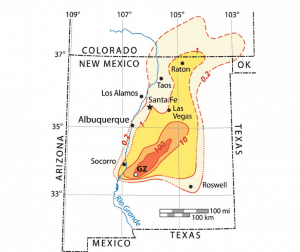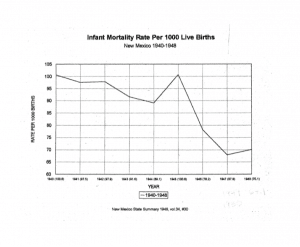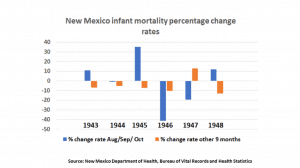Trinity: “The most significant hazard of the entire Manhattan Project”
By Kathleen M. Tucker, Robert Alvarez | July 15, 2019
Editor’s note: This article was originally published in 2019. We are republishing it as a public service on this 75th anniversary of the Trinity test.
For the past several years, the controversy over radioactive fallout from the world’s first atomic bomb explosion in Alamogordo, New Mexico on July 16, 1945—code-named Trinity—has intensified. Evidence collected by the New Mexico health department but ignored for some 70 years shows an unusually high rate of infant mortality in New Mexico counties downwind from the explosion and raises a serious question whether or not the first victims of the first atomic explosion might have been American children. Even though the first scientifically credible warnings about the hazards of radioactive fallout from a nuclear explosion had been made by 1940, historical records indicate a fallout team was not established until less than a month before the Trinity test, a hasty effort motivated primarily by concern over legal liability.
In October 1947, a local health care provider raised an alarm about infant deaths downwind of the Trinity test, bringing it to the attention of radiation safety experts working for the US nuclear weapons program. Their response misrepresented New Mexico’s then-unpublished data on health effects. Federal and New Mexico data indicate that between 1940 and 1960, infant death rates in the area downwind of the test site steadily declined—except for 1945, when the rate sharply increased, especially in the three months following the Trinity blast. The 21 kiloton explosion occurred on a tower 100 feet from the ground and has been likened to a “dirty bomb” that cast large amounts of heavily contaminated soil and debris—containing 80 percent of the bomb’s plutonium—over thousands of square-miles. (See Figure 1.)
After a nearly half a century of denial, the US Department of Energy concluded in 2006, “the Trinity test also posed the most significant hazard of the entire Manhattan Project.”[1] Four years later the US Centers for Disease Control gave weight to this assessment by concluding:
“New Mexico residents were neither warned before the 1945 Trinity blast, informed of health hazards afterward, nor evacuated before, during, or after the test. Exposure rates in public areas from the world’s first nuclear explosion were measured at levels 10,000- times higher than currently allowed.”[2]
Figure 1.

Estimated exposure rate in milliroentgens per hour (mR h-1) 12 hours after detonation; GZ = ground zero of Trinity. Source: Centers for Disease Control (2010).
Meanwhile the National Cancer Institute is conducting a study to model the dispersion and dose reconstruction for people who may have been exposed to fallout from the Trinity explosion. Regardless of the outcome of this study, it is clear the public was put in harm’s way because of US government negligence in conducting and its participation in a coverup of the results of an exceedingly dangerous experiment.
Infant mortality concerns raised about Trinity. In October 1947, the first concerns over a rise in infant mortality along the fallout path of the Trinity explosion were raised in a letter to Stafford Warren, a medical radiologist and radiation safety chief of the Manhattan Project and the Trinity test in particular. “As I recall, in August 1945, the month after the first bomb was tested in New Mexico, there were about 35 infant deaths here…” Kathryn S. Behnke, a health care provider from Roswell, New Mexico, wrote. “I understand the rate at Alamogordo, nearer the site of the test, was even higher than Roswell.”[3]
On December 4, 1947, Warren’s medical assistant, Fred A. Bryan, replied to Ms. Behnke, writing that “we can find no pertinent data concerning infant deaths; in fact there is no report as to the number of or specific cause or dates and, as far as Alamogordo is concerned.”[4] Bryan also wrote that he “wanted to assure you that the safety and health of the people at large is not in any way endangered.”[5]
Bryan failed to mention that he did not bother to examine New Mexico’s vital statistics. About a month after Bryan’s reassured Behnke of no evidence of harm, a state health official sent the actual unpublished data on infant deaths collected by the state to Los Alamos. [6] Soon thereafter, in a letter dated, January 22, 1948 to Bryan, Wright Langham, biomedical group leader at the Los Alamos National Laboratory (LANL), forwarded hand-written sheets from the state of “the records of infant births and deaths during 1945-1947.” Langham added: “I am sure what I am sending you will not be of much help.” The New Mexico Health Department data indicated that the infant death rate increased by 38 percent in 1945 compared to 1946 and was 57 percent higher than in 1947.[7]
Finding the facts. More than 70 years later, we examined the vital statistics collected by the US government and the state of New Mexico in the 1940s to determine if area health patterns changed after the first atomic explosion. The data eventually provided to Los Alamos and Bryan in January 1948 indicated a sharp rise in infant deaths following the Trinity explosion. Later, between 1940 and 1960, infant mortality in New Mexico showed steady and deep annual declines—except for 1945, when it shot up.[8] The infant mortality rate in New Mexico in 1945 was 100.8 per 1,000 live births; the rate for 1944 was 89.1, and for 1946 it was 78.2.[9] (See Figure 2.) The unpublished data sent to Los Alamos indicated an infant death rate nearly 34 percent higher in 1945 than subsequently made public.
Figure 2
 Month-by-month data for the years 1943 to 1948 revealed the highest infant mortality rates in late summer, following the Trinity blast, with a significant peak in September 1945. Infant mortality for the months August, September, and October after the explosion indicated that New Mexican infants had a 56 percent increased risk of dying, with less than a 0.0001 percent chance that this was due to natural fluctuation.[10]
Month-by-month data for the years 1943 to 1948 revealed the highest infant mortality rates in late summer, following the Trinity blast, with a significant peak in September 1945. Infant mortality for the months August, September, and October after the explosion indicated that New Mexican infants had a 56 percent increased risk of dying, with less than a 0.0001 percent chance that this was due to natural fluctuation.[10]
In 1945, infant death rates increased on average by 21 percent (with a statistical error range of plus or minus six percent that applies to all the rates listed in this paragraph) in counties where fallout was measured by Manhattan Project personnel. Rates in these counties dropped by an average of 31 percent in 1946. The infant death rate in Roswell, where Ms. Behnke first alerted Warren of the problem, climbed by 52 percent in 1945, after falling by 27 percent between 1943 and 1944. The rate then dropped in Roswell by 56 percent in 1946. Rates in the downwind counties where fallout was measured dropped by an average of 31 percent (plus or minus eight percent) percent in 1946
We found no extraordinary metrological conditions, such as heat or heavy rains and floods, that may have competed with radioactive fallout as a factor in the increase in newborn deaths after Trinity. According to the CDC in 2010, risks to newborns were especially heightened as “residents reported that fallout ‘snowed down’ for days after the blast, most had dairy cows and most collected rain water off their roofs for drinking.”[11]
The Trinity Test was conducted on July 16, 1945. The rate of infant mortality began rising in July. The month of August showed an infant mortality rate of 152.3 per 1,000 live births. In September, the rate was 187.8, and in October 123.1. Infant mortality change rates for August, September, and October show a dramatic increase in 1945 when compared to the same three months for the years 1943, 1944, 1946, 1947 and 1948 (see figure 3)
Figure 3

Ionizing radiation is especially damaging to dividing cells, so the developing infant, both before and after birth, is susceptible to radiation damage, as Alice Stewart, an epidemiologist who first demonstrated the link between X-rays of pregnant women and disease in their children,[12] first warned in 1956.[13] This damage may be seen years later with the development of leukemia and other cancers in children exposed in utero to ionizing radiation, as Stewart and others confirmed in subsequent studies.[14] By 1958, the United Nations Scientific Committee on the Effects of Atomic Radiation recognized that, in the short term, radiation damage can be reflected in fetal and infant deaths.[15]
Fallout protection was not a priority for the Trinity explosion. The Trinity test was top secret to all but a few scientists and military officials. No warnings were issued to citizens about off- site fallout dangers, although off-site measurements done with a paucity of instruments and people indicated that radiation spread well beyond the test site boundaries. [16]
The Trinity bomb was detonated atop a 100-foot steel tower. With an estimated explosive yield of 21,000 tons of TNT, the fireball vaporized the tower and shot hundreds of tons of irradiated soil to a height of 50,000 to 70,000 feet, spreading radioactive fallout over a very large area. Fallout measurements taken shortly after the explosion were very limited and primitive instruments were used; the data suggest no measurements regarding inhalation or ingestion of radionuclides were taken.
Joseph Shonka, a principal researcher for the study of the Trinity shot for the Centers for Disease Control, recently concluded that the Trinity fallout “was similar to what might occur with a dirty bomb. A fraction of the plutonium [~20%] was used in the explosion [and] … the fireball contacted the soil. Because of the low altitude, fallout exhibited a ‘skip distance’ with little fallout near the test site. Although there were plans for evacuation, radio communication was lost as the survey teams traveled out to follow the overhead plume. Thus, the command center was unsure of whether that the criteria had been met … and failed to order the evacuation.”[17]
Scientists had stressed the importance of protection from radioactive fallout following a nuclear weapon explosion, five years before the Trinity test. “Owing to the spread of radioactive substances with the wind, the bomb could probably not be used without killing large numbers of civilians, and this may make it unsuitable as a weapon for use by this country,” warned Manhattan Project physicists Otto Frisch and Rudolf Peierls in their important memorandum of March 1940, which accelerated production of the first atomic weapons. “[I]t would be very important to have an organization which determines the exact extent of the danger area, by means of ionization measurements, so that people can be warned from entering it.”[18]
As preparations were being made to test the first nuclear weapon, warnings by Frisch and Peierls about fallout hazards were lost on the leadership of the Manhattan Project. Were it not for two physicists at Los Alamos who warned in a June 1945 memorandum that “radiation effects might cause considerable damage in addition to the blast damage ordinarily considered,”[19] little would have been done. Later Joseph O. Hirschfelder, one of the concerned scientists, recalled that “very few people believed us when we predicted radioactive fallout from the atom bomb. On the other hand, they did not ignore this possibility.”[20]
On first being warned by Los Alamos scientists, Gen. Leslie Groves, the Manhattan Project director, dismissed concerns about fallout as being alarmist. But Warren convinced Groves of the potential risk of legal liabilities, and Groves grudgingly agreed to assemble a team at the last minute to track fallout from the test.[21]
A lot was at stake. First, there was the enormous expense involved; the Trinity device cost approximately 15 percent of what the United States spent on all conventional bombs and other explosives during World War II.[22] Then again, there was great pressure to test the Trinity device before July 17, 1945, when the three heads of government of the United States, the Soviet Union and Great Britain were to meet in Potsdam, a German suburb of Berlin, to address the end-stage of World War II and post-war policies. Compared to the political imperative of Potsdam, the hazards of radioactive fallout took a back seat.
But five days after the explosion, Warren reported to Groves that “a very serious hazard” existed over a 2,700 square mile area downwind from the test that had received high radiation doses.[23] Tissue-destructive effects from fallout were observed in livestock in areas that were incorrectly assumed to be uninhabited by people.[24] After realizing the magnitude of the problem, Warren advised Groves that the fallout danger zone, originally set at a 15-mile radius, was too small by at least an order of magnitude and that “there is still a tremendous quantity of radioactive dust floating in the air.”[25]
After more than 70 years, radiation exposures from inhalation and ingestion of water and food contaminated by Trinity test fallout were never assessed,[26] and it may prove to be difficult, if not impossible, to reconstruct doses from internal exposures, given the deaths of residents living in the vicinities from the passage of time and the major changes in lifestyles and dietary habits that have occurred since 1945. Fallout maps of the Trinity test have been made, but they contain strong elements of speculation because of the paucity of radiological monitoring at the time.
The National Cancer Institute is near completion of a fallout dispersion study of the Trinity explosion. Regardless of the outcome of this study, it is clear the public was endangered because of US government negligence in conducting a highly dangerous experiment, as was the case for the downwinders living near the Nevada Test Site, where above-ground nuclear tests were conducted. Because of passage of the Radiation Exposure Compensation Act in 1990, 22,220 “downwinders” exposed to fallout from open air nuclear weapons tests near the Nevada Test Site received an official apology from the US Government for sending them in harm’s way through deception. Through 2015, they had also received nearly $2 billion in financial compensation.[27]
But the people downwind of the 1945 explosion in New Mexico have been denied official recognition, even though the Trinity shot was considered one of the dirtiest of American nuclear tests, with a significant absence of safeguards to protect people from dense radioactive fallout. Safety took a back seat to making sure the first atomic bombs would meet their enormously destructive potential. Alvin Weinberg, director of Oak Ridge National Laboratory during and after the Manhattan Project captured the prevalent mindset in his memoir by saying that “all else, including safety, was secondary.”[28]
Several years ago, residents of central and southern New Mexico organized to fight for compensation. Known as the Tularosa Basin Downwinders, they have made a compelling case that cancers and other diseases are due to the Trinity blast and subsequent radioactive fallout from open air atomic bomb tests in Nevada.
Indeed, coming to terms with the legacy of the Trinity explosion through radiation dose reconstruction is further complicated by the fallout that drifted from the Nevada tests into New Mexico. As indicated by the Centers for Disease Control in 2005, northern and central New Mexico were among the areas where significant amounts of fallout were deposited from the Nevada open air atomic tests.[29] Even so, the strong correlation of increased infant deaths in the months following the Trinity explosion cannot be ignored.
We should remember that compensation for people near the Nevada test site was not exclusively based on abstract modeling of radiation doses. Rather, downwinders were also compensated because the burden of proof fell unfairly on them. They were victims not just of willful negligence, but also the government’s purposeful deception and suppression of evidence about the high-hazard activity that the US nuclear weapons program constituted. The current body of historical evidence of harm, negligence, and deception—especially the evidence of increased infant death following the first nuclear explosion—should be more than enough for long overdue justice for the people in New Mexico who were downwind of Trinity.
Endnotes
[1]Terrence R. Fehner & F. G. Gosling U.S. Department of Energy, Office of History, Battlefield of the Cold War, Atmospheric Nuclear Weapons Testing 1951-1963, DOE/MA-0003,p 25
[2] Final Report of the Los Alamos Historical Document and Retrieval and Assessment Project, Prepared for the Centers for Disease Control and Prevention, November 2010, pp. ES-34-35. https://wwwn.cdc.gov/LAHDRA/Content/pubs/Final%20LAHDRA%20Report%202010.pd
[3] Kathhryn S. Behnke, Chiropractor, Letter to: Dr. Stafford L. Warren, University of California, Los Angeles, CA, October 20, 1947.
[4] Fred A. Bryan, Letter to Katheryn S. Behnke, December 4, 1947.
[5] Ibid.
[6] Letter from Marion Hotopp, M. D., Dept. of Public Health, dated Dec. 19, 1947.
[7] Letter from Wright H. Langham,
[8] New Mexico Summary of Vital Statistics, 1945 vol. 26, #31, July 16, 1947 & Vital Statistics-Special Reports, Federal Security Agency
[9] Ibid
[10]Communication with David Richard, Professor and radiation epidemiologist at the University of North Carolina School of Public Health, November 27, 2017.
[11] op cit ref 3.
[12] See https://www.nytimes.com/2002/07/04/world/alice-stewart-95-linked-x-rays-to-diseases.html
[13] Stewart, Alice, Webb, J., Giles, D. & Hewitt, D., Malignant Disease in Childhood and Diagnostic Irradiation In Utero; Preliminary Communication, Lancet 2, 1956, p. 447
[14] Stewart, Alice, Webb, J., & Hewitt D., A Survey of Childhood Malignancies, BRITISH MEDICL JOURNAL 1, 1958, 1495-1508; MacMahon, Brian, Prenatal X-Ray Exposure and Childhood Cancer, J. NATIONAL CANCER INST., 28 (5) May, 1962, p. 1173; Diamond, Earl, Schmerler, Helen, & Lilienfeld, Abraham, The Relationship of Intra-Uterine Radiation to Subsequent Mortality and Development of Leukemia in Children, AMER. J. HYGIENE, 97 (5) May, 1973, 283; Sternglass, Ernest, Cancer: Relation of Prenatal Radiation to the Development of the Disease in Childhood, SCIENCE Vol. 140, 1963
[15] UNSCEAR 2001 Report, Hereditary Effects of Radiation, United Nations Scientific Committee on the Effects of Atomic Radiation, UNSCEAR 2001 Report to the General Assembly, with Scientific Annexhttp://www.unscear.org/docs/reports/2001/2001Annex_pages%208-160.pdf
[16] Op Cit ref 3.
[17] Personal communication with Joseph Shomka June 2019.
[18] Otto Frisch and Rudolf Peierls, Memorandum on the Properties of a Radioactive “Super-bomb,” March,1940.
[19] Hirschfelder and J. Magee to K. Bainbridge, “Danger from Active Material Falling from Cloud Desirability of Bonding Soil Near Zero with Concrete and Oil,” June 16, 1945, NTA.
[20] Joseph O. Hirschfelder, The Scientific and Technological Miracle at Los Alamos, Reminiscences of Los Alamos, 1943-1945, Boston: D. Reidel. Publishing Company, 1980, p.67.
[21] Ferenc Morton Szasz, The Day the Sun Rose Twice, University of New Mexico Press, (1984), pp-71-72
[22] Atomic Audit: The Costs and Consequences of Nuclear Weapons since 1940, Steven I. Schwartz Ed., The costs of the Manhattan Project, Brookings Institution Press, 1998. https://www.brookings.edu/the-costs-of-the-manhattan-project/
[23] Memorandum, To: Major Gen. Groves From: Colonel Stafford L. Warren, Chief of Medical Section
Manhattan District, Subject: Report on Test II at Trinity, 16 July 1945, U.S. National Archives, Record Group 77, Records of the Office of the Chief of Engineers, Manhattan Engineer District, TS Manhattan Project Files, folder 4, “Trinity Test.”
[24] U.S. Centers for Disease Control, Final Report of the Los Alamos Historical Document Retrieval and Assessment (LAHDRA) Project, November 2010, p.22-3. https://nnsa.energy.gov/sites/default/files/nnsa/multiplefiles2/ChemRisk%20et%20al%202010%20Final%20LAHDRA%20Report.pdf
[25] Memorandum, To: Major Gen. Groves From: Colonel Stafford L. Warren, Chief of Medical Section
Manhattan District, Subject: Report on Test II at Trinity, 16 July 1945, U.S. National Archives, Record Group 77, Records of the Office of the Chief of Engineers, Manhattan Engineer District, TS Manhattan Project Files, folder 4, “Trinity Test.”
[26] Op Cit ref 3, p.22-3. https://nnsa.energy.gov/sites/default/files/nnsa/multiplefiles2/ChemRisk%20et%20al%202010%20Final%20LAHDRA%20Report.pdf
[27] Congressional Research Service, The Radiation Exposure Compensation Act (RECA): Compensation Related to Exposure to Radiation from Atomic Weapons Testing and Uranium Mining, June 11, 2019. https://fas.org/sgp/crs/misc/R43956.pdf
[28] Alvin M/ Weinberg, The first Nuclear Era: The Life and Times of a Technological Fixer, The American Institute of Physics, New York (1994). P.188
[29] https://www.cdc.gov/nceh/radiation/fallout/feasibilitystudy/Technical_Vol_1_Chapter_3.pdf
Together, we make the world safer.
The Bulletin elevates expert voices above the noise. But as an independent nonprofit organization, our operations depend on the support of readers like you. Help us continue to deliver quality journalism that holds leaders accountable. Your support of our work at any level is important. In return, we promise our coverage will be understandable, influential, vigilant, solution-oriented, and fair-minded. Together we can make a difference.
Keywords: Trinity test
Topics: Analysis, Nuclear Risk, Nuclear Weapons

















The National Cancer Institute study will be the definitive expert conclusion on whether or not there are any discernable effects from the Trinity Test. However, the authors point about compensation for downwinders has broader implications. We know that 71,000 US citizens die each year due to air pollution (and 8 million deaths annually worldwide). Shouldn’t we be having a conversation about the downwinders of the nation’s ~1300 extant coal-fired power units, and the many more that have operated in the past? If the author’s concern is really human health, they will no-doubt commit to this objectively much larger and ongoing… Read more »
Personally, I was disappointed after reading this article. I found it to read more like a lawyer’s opening statement in a civil lawsuit. The title indicates to me the author’s either have a limited knowledge of the “entire Manhattan Project” or they intentionally chose this title for its shock value focusing especially to those readers with little or no knowledge of the subject matter. I am concerned when non-scientists become statisticians and analyze/present data to co-inside with a pre-determined conclusion. This article was one of those examples. Please note that I do not necessarily disagree with the possible conclusions, but… Read more »
Joseph Shonka I was quoted in the article and quoted by the previous commentator and wish to clarify the reasons for comparing Trinity to a dirty bomb. I had given a paper on the subject at the annual Health Physics Society meeting in 2019, and noted that the Mark III (solid pit) warhead burned only 15% of the plutonium in the warhead, and released more than 5 Kg of the initial 6 Kg of Pu-239 plus other TRU in the fallout. The author (Alvarez) talked to me and quoted me in his article. I believe I am the source of… Read more »
Trinity was a “dirty” shot given it was detonated atop a 100-foot tower and pulled up alluvial soil which then came to earth relatively quickly and in an irradiated state.
I-131 seems to be a big factor in infant deaths. When Fukushima melted, the British Columbia Coroner’s Office noted a doubling of infant deaths, lasting about 80 days — ten half-lives of I-131. But their conclusion was that the one-time spike, strangely co-incident with Fukushima’s meltdown, had to do with “poor parenting skills.” I guess the parents were all engrossed in TV coverage of Fukushima, and didn’t notice that their infant stopped breathing. Much earlier, University of Pittsburgh Professor of Epidemiology Ernest Sternglass did a similar study, and found that, while infant mortality had been steadily declining for decades, that… Read more »
What, in specific terms, supposedly caused the spike in infant mortality? Was it gamma radiation? Radioiodine? Strontium-90? I’d think the most likely scenario is radioiodine in cow’s milk ingested by children in the months after the Trinity detonation…?
There were health effects due to the Trinity detonation, and New Mexico downwinders certainly deserve to be taken seriously. However, data measured at the appropriate level do not illustrate Trinity fallout caused an uptick of infant mortality. (Email me for a copy of the data…the citation is below). Tucker and Alvarez highlight a spike of infant deaths in 1945—but this is measured at the state level—and they then infer from this radioactive fallout was the cause. This is a mistake. Infant deaths recorded at the county level highlight the increase occurred in areas of New Mexico characterized by little or… Read more »
January 25, 2022 Under their subheading “Finding the facts” Tucker and Alvarez write that “between 1940 and 1960, infant mortality in New Mexico showed steady and deep annual declines – except for 1945, when it shot up.” The increase from 1944 (89.1) to 1945 (100.8) was 1.13. To say infant mortality “shot up” from 1944 to 1945 might be a judgement call. From 1940 to 1960 the infant mortality rates per 1000 live births increased seven times. Most of these were small increases, but the rates increased in seven years. Whether or not any of the declines were “deep” declines is probably another judgment… Read more »
January 27, 2022 Tucker and Alvarez invoke Alice Stewart’s study showing increased leukemias (and a few other diseases) as a result of pre-natal exposure to x-rays. Any unborn children in the vicinity of the Trinity test were not exposed to x-rays but to fallout. They were too far from the test to have been exposed to gamma radiation, and their mothers’ bodies would have shielded them from the beta and alpha radiation. Stewart’s study cannot be applied to any unborn children whose mothers may have been near the Trinity test. According to a January 1970 article in Postgraduate Medical Journal, “A further, more… Read more »
January 28, 2022 Most of these comments pertain to Joseph Shonka’s reply to comments that were made by David Wargowski. I will also make a comment or two about the Tucker and Alvarez article. The article describes Shonka as “a principal researcher for the study of the Trinity shot [test] for the Centers for Disease Control.” This report is the Los Alamos Historical Document Retrieval and Assessment (LAHDRA) Project, and it is available online. According to the front matter of the report, Shonka was a “contributing author” to the report. Shonka says that the Manhattan District “purchased 75 head of cows that had… Read more »
Is the Trinity detonation associated with an uptick of infant mortality?
doi: 10.1097/HP.0000000000001505